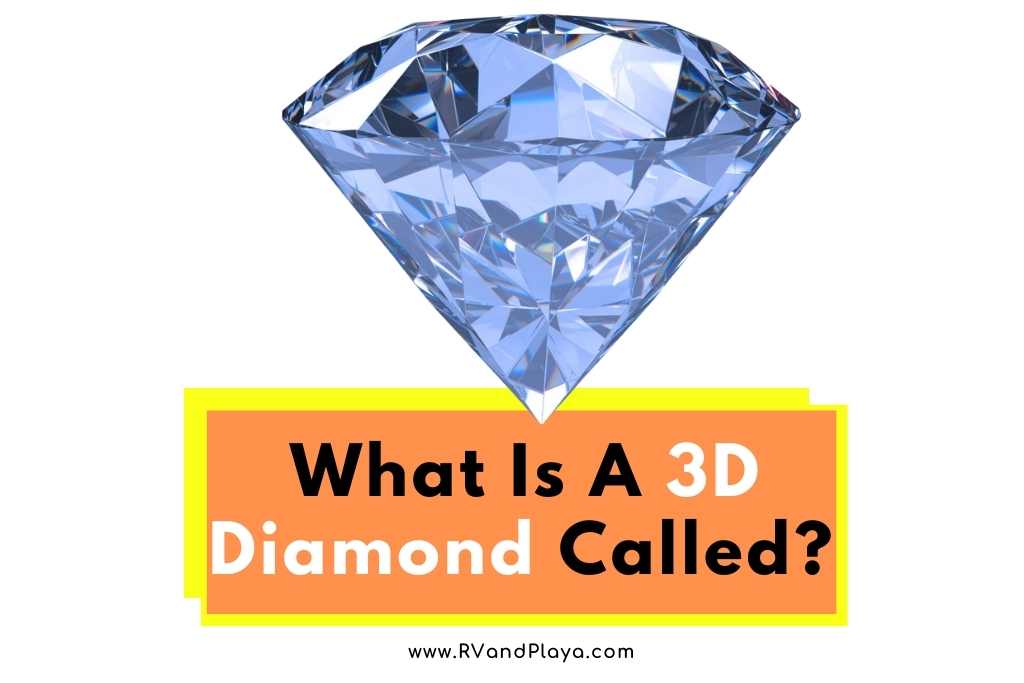The diamond as a precious gemstone is iconic for many reasons, but have you ever really considered the shape itself?
What we refer to as a diamond in two dimensions is very different from what we typically see in 3-dimensional stones, so what is a 3D diamond called?
The most basic 3D diamond shape would typically be an octahedron because it has 8 faces. Gemstone diamonds, however, will almost always have far more faces than this.
Read ahead to understand much more about the fascinating shapes of the world’s most famous gemstone.
Table of Contents
What Is The Name Of A Diamond’s Shape?
Although you might remember being taught about a “diamond” shape in school, that’s actually a bit of a misnomer.
There is no geometric shape known as a “diamond”, and what many people consider to be one is a different shape entirely.
The 2D diamond shape is technically a rhombus. It has four sides and two sets of parallel lines, and all of its sides are equal in length. The only thing that separates it from being a square is the fact that the internal angles are not 90 degrees.
Sometimes, this shape is also referred to as a “lozenge”, which can be a synonym for a rhombus, but generally refers to one that is slightly thin – with two acute angles and two obtuse angles.
If you rotate a “diamond”, you will see exactly what this means. With one of its flat edges as a baseline, it is quite obviously a rhomboid, which has an appearance similar to that of a square that has been pushed to one side.
Shapes don’t have different names based simply on the direction from which you look at them. A triangle from any direction is a triangle, and a rhombus from any direction is a rhombus.
With that being said, this shape is still one of the most famous and well-known quadrilaterals in the world, but what about the shape of a 3D diamond? How does that differ?
Read also >> What Is A Blue Diamond Called? (All You Need To Know)
Read also >> What Is A Green Diamond Called? (All You Need To Know)
Read also >> What Is A Lab Grown Diamond Called? (All You Need To Know)
What Is The Word For A 3-Dimensional Diamond?
A 3D diamond, in the most basic shape that you can imagine, is a form of octahedron. It simply has 8 faces. You could almost think of it as two square-based pyramids attached at the base. It has 4 triangular faces on one side of the shape, and another four triangular faces on the other side.
When you actually think about it, though, this is not the shape of any real-world diamond that you will ever have seen.
Even the simplest of cut diamonds will be far more complicated and have a much higher number of faces than an octahedron.
Why Do We Call It A Diamond Shape?
Although it does bear some resemblance to the projection on a three-dimensional diamond (the pointed end), the “diamond” shape is quite unlike the actual diamonds that you see today.
There are a few reasons why this name has been attributed to shapes like rhomboids and octahedrons.
Interestingly, the shape that we associate with diamonds now was one of the traditional cuts that were used many years ago, when the process of diamond cutting began in the 6th century AD.
It was known as the “Point Cut”, and slowly evolved through the years to the more complicated cuts that are commonly used in the modern era.
This diamond shape is associated with the suit “diamonds” in playing cards, which is represented by the quintessential rhombus.
In their rough form, diamonds are vaguely octahedron-like in shape as well, and many crystals actually form with a similar geometric projection due to their internal structure and the way that the molecules align.
Quartz crystals, for example, naturally develop a triangular pyramid projection at the end, which gives them a very diamond-like appearance and adds to the association between the shape and the stone.
If you’re shopping for cut diamonds, however, then the idea of shape gets a whole lot more complicated.
Why Are Diamonds Shaped The Way That They Are?
Cutting diamonds is an incredibly complex, expertly skilled, and highly nuanced art form. These beautiful gemstones are not shaped into simple octahedrons or rhomboid shapes anymore – instead, they are carefully given a great number of different faces to create the perfect diamonds that we know and love.
There are three main reasons for this. One is for setting. The general overall shape of a diamond – with a pyramid at one end and a wider “top” at the other – allows them to be set relatively easily into jewelry.
One of the main reasons why diamonds hold such high value and are so sought-after in the gemstone world is their use in engagement rings, so they are almost always shaped in a way that allows them to be fitted comfortably into a traditional ring.
Another reason for their complicated shape is to do with light. Diamonds are famously bright and beautiful, and a huge part of that comes down to the way they are cut.
All of the different faces and angles on the stone reflect light to create sparkle, and the quality of the cut will determine just how bright a diamond is, and how much light shines from it.
The other reason for their shape is nice and simple: aesthetic. They are beautiful and valuable gemstones, so you want them to look good.
The geometric pattern cut into them, and the overall shape that they are given, are designed to be as attractive as possible.
What Different Shapes Do Diamonds Come In?
There are a number of different shapes that diamonds are carved in, to suit different tastes and different purposes, but they are all highly intricate and stunning to look at.
They are about as varied and unique as each gemstone itself.
The traditional diamond shapes that you will see when you are shopping around are:
- Round: The most common shape, making up around 75% of the market. They have many different faces to create a circular appearance and give off the most light. These are typically the most valuable diamonds.
- Princess Cut: A favorite among the fancy cuts, the princess has a distinctly square shape from above and is well-suited to engagement rings.
- Oval: With a long, wide oval shape, these are bright and reflect light very well. They also tend to appear even larger than they actually are.
- Marquise: Shaped like a football (with a point at either end) these diamonds are narrow but long and have one of the largest surface areas of any shape by the carat weight of the gem itself.
- Pear-Shaped: With a rounded top and a pointed tip, these diamonds should be very symmetrical.
- Cushion Cut: A cushion cut diamond looks like a rounded square, similar to a pillow.
- Emerald Cut: With one large open face and slightly rounded edges, this diamond shape resembles a rectangular tabletop.
- Asscher Cut: Named after the Asscher Brothers who first designed it, the Asscher cut is similar to an emerald cut but with a smaller top face and larger facets around the edges.
- Radiant Cut: The strongly rectangular shape of a radiant cut is somewhere between a princess and a cushion.
- Heart-Shaped: Quite self-explanatory, the heart-shaped diamond cut is a complicated shape to carve but very highly favored for romantic jewelry.
- Save an Average of $350* on Lab-Created Diamonds
- James Allen is the leader in online diamond sales
How Does A Diamond’s Shape Affect Its Price?
With all of the different shapes to choose from, it can be hard to decide what you might actually prefer.
It is important to note that the shape of a diamond will not only have an impact on its appearance and how it can be set into jewelry: it will also change its value.
Read also > > How Much Is a 1 Carat Uncut Diamond Worth?
Different diamond shapes come with a different average price, which can vary more than you might think – even for stones of the same quality.
Let’s take a look at the lowest value a G color VS2 diamond would generally be given, based on its shape and carat weight.
| Shape | 0.5-Carat Lowest Price | 1-Carat Lowest Price |
|---|---|---|
| Round | $1,700 | $7,300 |
| Princess | $1,300 | $4,800 |
| Oval | $1,200 | $5,300 |
| Cushion | $1,200 | $4,200 |
| Pear | $1,300 | $5,800 |
| Radiant | $1,000 | $4,500 |
| Emerald | $1,200 | $4,500 |
| Asscher | $1,200 | $4,100 |
| Marquise | $1,300 | $5,600 |
| Heart | $1,300 | $5,500 |
What Other Terminology Is Important When Considering A Diamond’s Shape?
The general shape is only one aspect of diamond cutting. There are many other terms and phrases that you will hear which are also important.
Some of these include:
- Facet Count: The number of overall facets the shape has
- Crown: The top half of the stone
- Pavilion: The bottom half of the stone
- Girdle: The middle part of the stone
- Polish: Smoothness of the facets
James Allen is the leader in online diamond sales. Their imaging technology is the same as inspecting a diamond with a jeweler's loupe. They have the largest exclusive loose diamond inventory online and fantastic prices.
They also have the nicest collection of lab created diamonds online. Save 10% off select lab grown diamonds and 25% off ring settings during limited time sale!
WHAT WE LOVE ABOUT THEM:
- No questions asked returns within 30 days of shipment. James Allen will send you a paid shipping label to return the ring.
- Lifetime Warranty
- Free International Shipping
- Free prong tightening, repolishing, rhodium plating and cleaning every 6 months
- Provide insurance appraisals
- One free resizing within 60 days of purchase
- Free ring inscriptions
- Best-in-class high quality imagery of all diamonds in stock
- 24/7 Customer Service
- Best-in-class packaging
Summary
So, what do you need to know about the name of a 3D diamond’s shape? It is technically not called a “diamond” at all, even in two dimensions.
A 2D diamond is actually a rhombus, and a simplified 3D diamond is an octahedron.
You would almost never see such simple shapes in actual diamonds today, however. Although a Point Cut from many hundreds of years ago might have been a straightforward octahedron shape, modern diamonds are given much more complex and intricate shapes.
References
https://en.wikipedia.org/wiki/Diamond_cut
https://www.gemsociety.org/article/diamond-shapes-price-size/
Recent Posts
When you're shopping for diamonds on a budget, you may be looking at lab created diamonds as a more affordable option than their naturally formed options. But with all the man-made options out...
Diamonds may be a girl’s best friend, but they can also be your wallet’s best friend too if you are in possession of real gemstones – even uncut diamonds. A 1 carat uncut diamond is priced...


